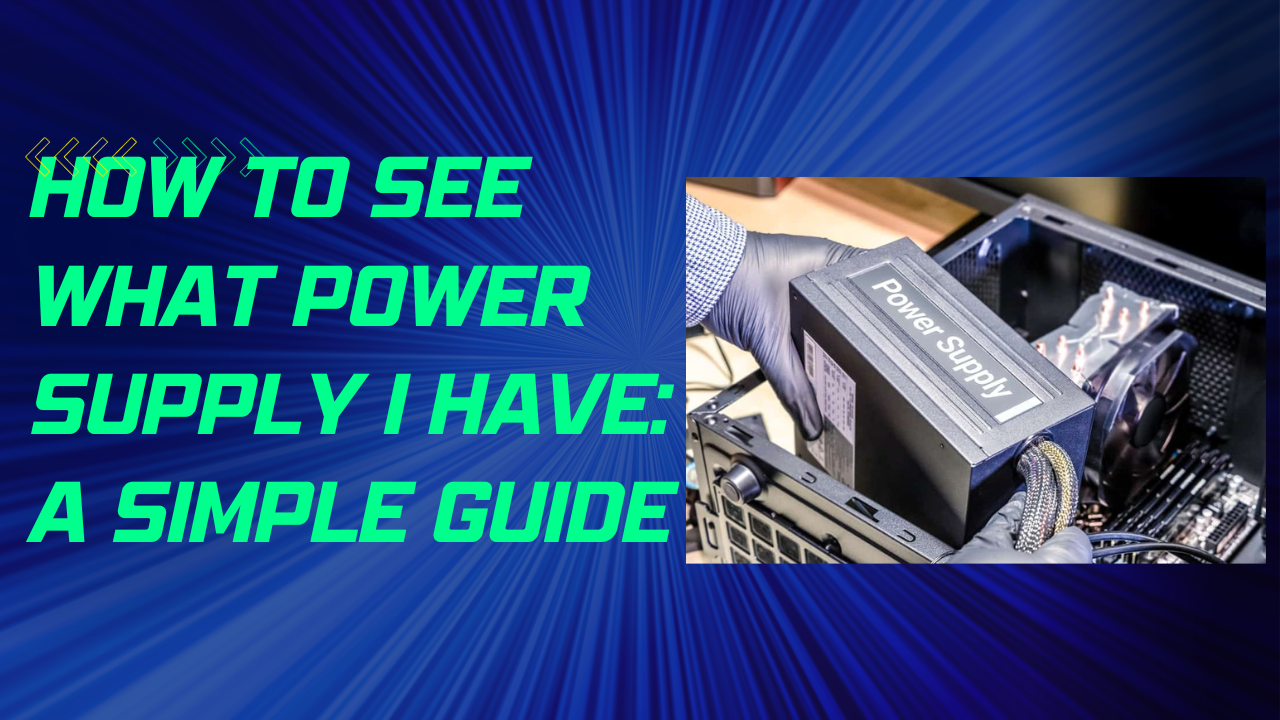To see what power supply you have, shut off your PC, unplug everything, remove one of the side panels of the case, and look at the power supply unit for the model and wattage information. Another way is to search for your PC’s model number on the manufacturer’s website and check the product specifications for the power supply type listed.
Understanding Power Supplies
To see what power supply you have in your PC, simply turn off your computer, unplug everything, and remove one of the side panels of the case. Look for a sticker on the power supply unit that contains the model and wattage information.
What Does A Power Supply Do?
A power supply is a crucial component of any electronic device, including computers. Its primary function is to convert AC (alternating current) power from the electrical outlet into DC (direct current) power that is compatible with the device’s internal components. In simpler terms, it provides the necessary electrical energy for the device to function properly.
Power Supply Features To Consider
When it comes to selecting a power supply for your device, there are several features to consider:
- Wattage: The wattage of a power supply determines how much power it can deliver to the device. It’s essential to choose a power supply with sufficient wattage to meet the power demands of your device and any potential upgrades in the future.
- Efficiency: Power supply efficiency refers to how effectively it converts AC power to DC power. Higher efficiency means less wasted energy and lower operating costs. Look for power supplies with 80 Plus certification, as they meet specific efficiency standards.
- Connectors: Different devices require various types of connectors to connect the power supply to their internal components. Ensure that the power supply you choose has all the necessary connectors to match your device’s requirements.
- Modularity: Modular power supplies offer the advantage of customizable cable management. They allow you to connect only the cables you need, reducing clutter and improving airflow within the device.
- Noise level: The noise level of a power supply is an important consideration, especially for those who prefer a quiet working environment. Look for power supplies with features like fanless operation or low-noise fans for a quieter experience.
Power Supply Length And Sizing
Power supplies come in different lengths, and choosing the right size is crucial to ensure compatibility with your device’s chassis. Measure the available space inside the chassis before purchasing a power supply to ensure it fits properly. Additionally, consider the form factor (ATX, Micro ATX, etc.) and ensure compatibility with your device’s motherboard.
Note: It’s always a good idea to consult your device’s manual or the manufacturer’s specifications for recommended power supply sizes and form factors.
Modular Power Supply Plugs
Modular power supplies offer flexibility in cable management by providing detachable cables for different components. This allows you to connect only the necessary cables, reducing clutter and improving airflow. Ensure that each modular power supply plug is securely attached to its corresponding component to prevent any loose connections or power delivery issues.
Checking Your Power Supply
When it comes to troubleshooting hardware issues on your computer or laptop, checking your power supply should be one of the first things to do. A faulty power supply can cause a variety of problems, from random shutdowns to poor system performance. In this section, we will walk you through the steps to check your power supply and identify any potential issues.
Testing A Psu (power Supply Unit) On A Pc
If you suspect that your power supply might be the culprit behind your computer’s issues, you can perform a simple test to check its functionality. Here’s how:
- Shut off the PSU: Before you begin, it’s important to shut off the power supply. Locate the power switch at the back of your PC’s power supply unit and turn it off.
- Turning on the PSU and checking fan activity: Once the power supply is shut off, turn it back on and observe the fan activity. If the fan spins smoothly and consistently, it indicates that the power supply is functioning properly.
Troubleshooting Laptop Power Supply Issues
If you’re experiencing power supply issues with your laptop, here are some troubleshooting steps you can take at home:
- Connecting the power cable: Ensure that the power cable is securely connected to your laptop and the power source.
- Checking for bent pins and power port issues: Inspect the AC adapter and the power port on your laptop for any bent pins or physical damage.
- Draining electricity and reseating the battery: To reset the power supply, disconnect the power cable and remove the laptop battery. Hold down the power button for 10-15 seconds to drain any residual electricity. Then, reseat the battery and reconnect the power cable.
- Checking the adapter and wall outlet: Plug the AC adapter into a different wall outlet to ensure that the issue is not related to the power source. Additionally, check if the indicator light on the adapter is functioning properly.
Monitoring Computer Wattage And Power Consumption
If you’re curious about your computer’s wattage and power consumption, you can use software tools to monitor them. Some popular options include:
- Software for power consumption monitoring: There are various software applications available that can provide real-time information about your computer’s power usage. Examples include HWMonitor, Open Hardware Monitor, and Joulemeter.
- Recommended PSU wattage based on device specifications: It’s essential to match your power supply’s wattage with your device’s requirements. You can refer to the manufacturer’s website or the device’s documentation for the recommended PSU wattage. It’s crucial to ensure that your power supply can provide enough power for all the components in your system.
How To Find Power Supply Information For Your Pc
When it comes to understanding the power supply of your PC, it’s important to know what kind of power supply you have installed. Whether you’re looking to upgrade your power supply or troubleshoot any issues, knowing the specifications of your current power supply is essential. In this guide, we’ll explore two methods to help you find power supply information for your PC – checking the manufacturer’s website and using the model number to find PSU specs.
Checking The Manufacturer’s Website
One of the easiest ways to find power supply information for your PC is by visiting the manufacturer’s website. Manufacturers typically provide detailed information about their products, including power supply specifications. To do this, follow these simple steps:
- Locate the model number of your PC. You can usually find it on a sticker on the back or side of the tower.
- Open your preferred web browser and navigate to the manufacturer’s website.
- Look for a support or product section on the website.
- Enter the model number of your PC in the search or product lookup field.
- Find the product page that matches your PC model and navigate to it.
- Scroll down or look for a tab labeled “Specifications” or “Tech Specs.”
- Look for the power supply specifications, which may include the wattage, efficiency rating, and connector types.
Using The Model Number To Find Psu Specs
If you can’t find the power supply information on the manufacturer’s website or you’re looking for an alternative method, you can use the model number of your PC to find the PSU specs. Here’s how:
- Locate the model number of your PC. This can be found on a sticker on the back or side of the tower.
- Open your preferred web browser and go to your favorite search engine.
- Type in the model number of your PC, followed by “power supply specifications” or “PSU specs.”
- Hit enter and browse through the search results.
- Look for reliable sources such as manufacturer websites, tech forums, or review sites that provide detailed information about your PC’s power supply.
- Once you find a trusted source, look for the power supply specifications, including the wattage, efficiency rating, and connector types.
By following these methods, you can easily find the power supply information for your PC. Remember to check the manufacturer’s website first for accurate and detailed specifications. If you’re unable to find the information there, using the model number to search for PSU specs can be a helpful alternative. Armed with this information, you’ll be better equipped to upgrade or troubleshoot your power supply efficiently.

Credit: www.xppower.com
Frequently Asked Questions On How To See What Power Supply I Have
How Do I Check My Power Supply?
To check your power supply, follow these steps: 1. Shut off your PSU. 2. Turn on the PSU and see if the PSU fan turns. For laptops, troubleshoot by: 1. Connecting the power cable. 2. Checking for bent pins on the AC adapter and power port.
3. Draining electricity from the laptop. 4. Removing and reinserting the battery. 5. Checking if the adapter is plugged in properly. 6. Checking the indicator light and wall outlet. For PCs, refer to the manufacturer’s website and search for your PC model’s PSU specifications.
Look for the PSU information on the sticker attached to the power supply unit.
How Do I Check My Laptop Power Supply?
To check your laptop power supply, follow these troubleshooting steps: 1. Connect the power cable and make sure it’s plugged into a wall outlet. 2. Check for any bent pins on your AC adapter and power port. 3. Drain electricity from the laptop by disconnecting the power cable and holding down the power button for 30 seconds.
4. Remove the battery and put it back in. 5. Check the indicator light on the AC adapter and make sure it’s working. 6. Finally, verify that the wall outlet is functioning properly.
How Do I Check My Computer Wattage?
To check your computer wattage, follow these steps: 1. Turn off your computer and unplug everything. 2. Open the case and locate the power supply unit (PSU). 3. Look for a sticker or label on the side of the PSU. 4.
The wattage information should be listed on the sticker. 5. If you’re unable to find the information, you can search for your computer’s model number on the manufacturer’s website for the PSU specifications. Remember to refer to your computer’s model number or the manufacturer’s website for accurate wattage information.
What Power Supply Do I Need For Rtx 3060?
To determine the power supply you need for an RTX 3060, check your PC’s manual or search the manufacturer’s website for the specifications. It’s important to match the recommended wattage for optimal performance.
Conclusion
To easily identify the power supply in your PC without the need to open up the case, you can follow a few simple steps. First, check the manufacturer’s website and enter your PC’s model number to find the PSU specifications.
You can also search for your PC’s service manual or manual, which should provide information about the power supply wattage. Another option is to do a quick Google search of your PC’s model number and look for the PSU type listed in the product specifications.
With these methods, you’ll be able to determine what power supply your PC has without any hassle.





Leave a Reply